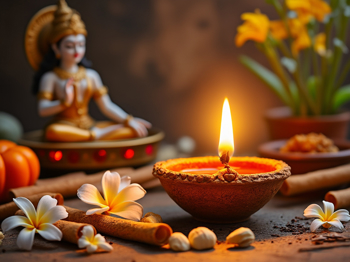



Mahalakshmi Vratam is a significant Hindu festival observed by devotees, especially in the southern and western parts of India, to worship Goddess Mahalakshmi, the goddess of wealth, prosperity, and fortune. The vratam (fast) typically spans 16 days, beginning on the eighth day of the waxing moon (Ashtami) in the month of Bhadrapada (August-September) and concluding on the full moon day (Purnima). This period is considered highly auspicious for invoking the blessings of Goddess Mahalakshmi, ensuring wealth, prosperity, and overall well-being in the household. Women, in particular, observe this vratam with great devotion, performing special rituals and pujas to seek the divine blessings of the goddess.

The Mahalakshmi Vratam holds immense spiritual and cultural significance. It is believed that during this period, Goddess Mahalakshmi descends from her celestial abode to bless her devotees with wealth, prosperity, and happiness. The vratam is also associated with the fulfillment of desires, protection from financial difficulties, and the overall prosperity of the family. By observing this vratam with devotion and sincerity, devotees believe that they can invoke the goddess's grace to remove obstacles, attract positive energies, and ensure the well-being and prosperity of their loved ones.
Attraction of Wealth and Prosperity: Observing the vratam is believed to invoke the blessings of Goddess Mahalakshmi, attracting financial stability, wealth, and prosperity into the household.
Fulfillment of Desires: Devotees who observe the Mahalakshmi Vratam with faith are often blessed with the fulfillment of their deepest desires, whether related to wealth, family, or personal aspirations.
Protection from Financial Difficulties: The vratam is considered a powerful remedy for overcoming financial challenges, debts, and economic hardships, bringing stability and abundance.
Promotion of Family Harmony: By performing the rituals together, families strengthen their bonds, ensuring peace, love, and mutual understanding among members.
Spiritual Growth and Devotion: The vratam enhances spiritual awareness and deepens the devotee's connection with the divine, leading to inner peace and contentment.
Health and Well-being: Observing the vratam with discipline, including fasting and prayers, is believed to purify the body and mind, contributing to overall health and well-being.
Removal of Obstacles: The goddess's blessings are sought to remove any obstacles or negative energies that may hinder personal or professional progress.
By following these steps with devotion and sincerity, you can perform the Mahalakshmi Vratam, inviting prosperity, happiness, and the blessings of Goddess Mahalakshmi into your life.
Mahalakshmi Vratam Katha
The Mahalakshmi Vratam, also known as Varalaxmi Vratam, is a significant Hindu festival primarily observed in South India, especially in states like Tamil Nadu, Andhra Pradesh, Karnataka, and Maharashtra. This vrat (fast) is dedicated to Goddess Lakshmi, the goddess of wealth, prosperity, and well-being. It is believed that observing this vrat with devotion and faith brings prosperity, happiness, and long life to the family.
Here is the story (Katha) associated with Mahalakshmi Vratam:
The Story of Charumati:
Once upon a time, in a town called Kundinpur, there lived a pious and devout woman named Charumati. She was a devoted wife and was very dedicated to her family. She was known for her virtues and for taking care of her household with great love and affection.
One night, Goddess Mahalakshmi appeared in Charumati's dream. The goddess was pleased with Charumati's devotion and told her, "I am pleased with your devotion and service towards your family. I bless you and your family with wealth, prosperity, and happiness. You should observe a fast (vrat) on the day of Shravana Shukla Ashtami (the eighth day of the bright fortnight of the lunar month of Shravana). By doing so, you will always have my blessings, and your family will never face any difficulties."
The next morning, Charumati woke up and narrated the dream to her family and the women in her neighborhood. Everyone was excited and decided to observe the Mahalakshmi Vratam together. On the auspicious day, Charumati, along with the other women, cleaned their houses, decorated their homes with flowers and rangolis, and prepared an altar to worship Goddess Lakshmi.
They performed the puja (worship) with great devotion, offering flowers, fruits, and sweets to the goddess. They also tied a sacred thread around their wrists as a symbol of the vrat. As they performed the puja, they chanted the mantras and sang songs in praise of Goddess Lakshmi.
Goddess Lakshmi was very pleased with their devotion and appeared before them. She blessed all the women, granting them wealth, prosperity, and happiness. From that day onwards, Charumati and the women of Kundinpur observed the Mahalakshmi Vratam every year, and their families flourished with the blessings of the goddess.
The vrat became popular, and it spread to other regions. Women began observing this vrat with great faith, believing that it would bring prosperity, happiness, and long life to their families. Even today, women across India observe the Mahalakshmi Vratam, praying for the well-being of their families and seeking the blessings of Goddess Lakshmi.
This katha is recited during the Mahalakshmi Vratam to remind devotees of the importance of devotion, faith, and the blessings of Goddess Lakshmi. Observing this vrat is believed to bring peace, prosperity, and abundance to the household.